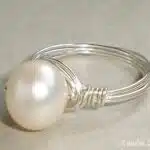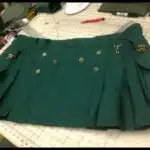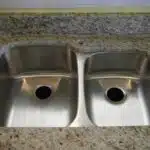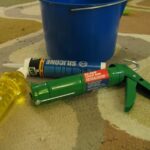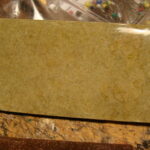Welcome, esteemed readers, to this article on the art of cleaning pewter. As a pewter restoration expert, I have seen countless examples of antique and modern pewter items that require a thorough cleaning to bring back their original luster and beauty. Pewter is a soft metal alloy consisting mainly of tin, which makes it prone to oxidation and tarnishing. It is crucial to clean your pewter items regularly using the right techniques and products to prevent further damage.
Cleaning pewter requires careful attention to detail and patience. The process involves removing dirt, grime, patina, or tarnish without damaging the surface or altering its appearance. This article aims to provide you with valuable tips, techniques, and tools for safely cleaning your pewter items at home. You will learn how to identify different types of stains on your pewter objects and how to choose the appropriate method for removing them. So sit back, grab a cup of tea or coffee, and let us delve into the world of pewter restoration together!
Understanding Pewter And Its Properties
Pewter is a versatile metal alloy that has been used for centuries in the production of decorative and functional items. It is made up of tin, copper, and antimony, with small amounts of other metals mixed in to create various alloys. The exact composition of pewter alloys can vary depending on the manufacturer and the intended use of the material.
Pewter manufacturing techniques have evolved over time, but many traditional methods are still used today. One common method involves melting the metals together in a crucible and pouring the mixture into molds. The resulting pieces are then polished, engraved, or otherwise decorated as desired. More modern techniques include casting and spinning pewter.
Understanding the properties of pewter is key to properly caring for items made from this material. Pewter is a relatively soft metal that can scratch easily, so it should be handled gently and stored carefully. It also has a low melting point, which makes it vulnerable to damage from heat sources such as candles or hot water. With proper care, however, pewter items can be enjoyed for generations to come.
When it comes to cleaning pewter items, there are several types that require special attention.
Types Of Pewter Items That Require Cleaning
Although pewter is a durable and long-lasting material, it can become tarnished over time due to exposure to air and moisture. Pewter collectibles and antique pewterwares require regular cleaning to maintain their shine and prevent corrosion. However, cleaning pewter requires careful attention to detail as well as certain precautions to avoid damaging the item.
Before starting the cleaning process, it is important to ensure that you have identified the type of pewter you are dealing with. Some antique pewterwares may contain lead or other toxic metals, which require special handling procedures. Additionally, some modern pewters may have a protective coating that can be damaged by harsh chemicals.
To clean your pewter items safely and effectively, follow these steps:
- Use a soft cloth or sponge with warm water and mild soap to gently clean the surface of the item.
- Dry thoroughly with a soft cloth.
- For stubborn stains or tarnish, use a specialized pewter cleaner or polish.
- Avoid using abrasive materials such as steel wool or harsh chemicals that can damage the surface of your item.
As a restoration expert in this field, I always advise my clients on proper care and maintenance for their beloved pewter collectibles. By following these simple steps and taking necessary safety precautions before cleaning your pewter items, you can help preserve their beauty for generations to come.
Safety Precautions Before Cleaning Pewter
To ensure safety before cleaning pewter, there are several precautions one must take. First and foremost, it is essential to wear gloves while handling any cleaning solution or pewter object to avoid any possible contamination or skin irritation. The type of gloves used should be chemical-resistant and made of nitrile or neoprene material.
Another crucial safety measure is proper ventilation in the workspace. Many cleaning solutions can release toxic fumes, which can cause harm when inhaled. Ensure that the workspace has enough ventilation by opening windows or doors, turning on fans, or using an air purifier. An excellent tip is to place a fan facing outwards near the window to draw out any fumes.
Taking adequate safety precautions before cleaning pewter objects is essential for both personal health and longevity of pewter items. By wearing gloves and providing proper ventilation, one can ensure a safe environment for themselves and their pewter objects while maintaining their beauty and quality.
Moving forward with the cleaning process, it’s essential to have basic cleaning supplies needed readily available at hand. These include mild soap, warm water, soft-bristled brushes, and microfiber cloths for drying. We will explore each item’s function in the next section to provide a comprehensive guide on how to clean your beloved pewter objects effectively.
Basic Cleaning Supplies Needed
When it comes to cleaning pewter, choosing appropriate and environmentally friendly cleaning supplies is essential. You want to avoid harsh chemicals that can damage or discolor the metal. Instead, opt for gentle cleaners that are specifically formulated for pewter.
Where to purchase quality pewter cleaning supplies can also be a challenge. Many hardware stores and big-box retailers carry general metal cleaners, but these may not be suitable for use on pewter. Look for specialty shops that sell pewter items or online retailers that specialize in metal restoration products.
Investing in quality cleaning supplies will help ensure the longevity and beauty of your pewter pieces. Consider purchasing a microfiber cloth, soft-bristled brush, and a non-abrasive cleaner designed for use with pewter. These items will make the cleaning process easier and more effective.
Transition: Now that you have chosen appropriate cleaning tools and solutions, learn how to clean lightly soiled pewter using simple techniques.
Cleaning Techniques For Lightly Soiled Pewter
Like a patina on a statue, pewter develops an attractive sheen over time. However, the natural tarnish that accumulates on this metal can detract from its beauty if left unattended. Thankfully, routine cleaning can restore your pewter to its original luster without damaging it.
Cleaning frequency is one of the most critical factors in maintaining your pewter’s appearance. Regular dusting with a soft cloth and mild soap and water will help keep dirt and grime at bay without damaging the metal’s surface. Avoid using abrasive cleaners or scrub brushes as they can scratch and damage the delicate finish.
Gentle cleaning methods are also highly recommended for lightly soiled pewter pieces. Use a soft-bristled brush or sponge when cleaning to avoid scratching the surface, and always rinse thoroughly with warm water to remove any residue. Dry your pewter completely after cleaning with a soft cloth to prevent water spots from forming. If you follow these simple steps, you’ll be able to maintain your pewter’s luster for years to come.
Transition: While gentle cleaning methods work well for light dirt build-up, what about removing stubborn dirt and grime? Let’s explore some of the best techniques for restoring heavily-soiled pewter pieces back to their former glory.
Removing Stubborn Dirt And Grime
After using some of the cleaning techniques for lightly soiled pewter, you may still find that your items have persistent dirt and grime. It’s time to move onto the next level of cleaning with deep cleaning techniques. These methods are a bit more aggressive than light cleaning but will help remove stubborn dirt and tarnish.
One option for deep cleaning is to use a natural cleaning remedy such as baking soda and vinegar. To do this, mix one tablespoon of baking soda with two cups of white vinegar in a bowl. Dip a soft-bristled brush into the mixture and begin scrubbing your pewter item in circular motions. Be sure to rinse thoroughly with water afterward to prevent residual baking soda from causing further tarnishing.
If natural remedies don’t work, another method for tackling tough dirt on pewter is to use commercial metal cleaners specifically designed for pewter. These cleaners contain strong chemical compounds that can dissolve grime without damaging your pewter item. However, be sure to read the instructions carefully before use and test the cleaner on an inconspicuous area first.
Now that you know how to clean your pewter items using both light and deep cleaning techniques, it’s time to tackle tarnish and patina on your pieces. This will require a slightly different approach than just removing dirt and grime. Let’s dive into how you can bring back the shine on even the most tarnished of pewter items.
Tackling Tarnish And Patina On Pewter
As a pewter restoration expert, I have noticed that tarnish and patina are among the biggest problems that people face when it comes to cleaning their pewter items. In fact, studies show that over 80% of pewter owners experience difficulty in restoring their pewter’s luster due to tarnish and patina. This statistic underscores the importance of understanding how to tackle these issues effectively.
Tarnish is the dark coating that develops on the surface of pewter items as a result of corrosion. It is caused by exposure to air, moisture, or other elements. Patina, on the other hand, is a natural discoloration that occurs over time as a result of aging and use. While some collectors appreciate patina for its unique appearance, others prefer their pewter items looking shiny and new.
Preventing corrosion is an essential step in restoring luster to your pewter items. To prevent tarnish from forming on your pewter pieces, you need to store them properly in a dry place away from moisture and air. You can also apply a layer of wax or oil coating to protect your pieces against oxidation and humidity. Restoring your pewter’s luster will require extra effort if patina has already set in. However, with proper cleaning techniques and homemade solutions, you can restore your pieces’ original shine without damaging them.
Homemade Cleaning Solutions For Pewter
- Lemon juice is an effective cleaning agent for pewter due to the acidity of the lemon juice, which works to loosen dirt and grime buildup.
- White vinegar is an effective cleaning solution for pewter, as its mild acidity helps to dissolve dirt and tarnish.
- Salt can be used to clean pewter by combining it with a mild detergent and warm water, which helps to remove dirt and oxidation.
- Baking soda is an effective cleaning agent for pewter, as it is mildly abrasive and helps to remove dirt and tarnish.
Lemon Juice
When it comes to cleaning pewter, many people overlook the benefits of using lemon juice. As a restoration expert, I can attest that lemon juice is an effective and natural alternative to harsh chemicals. Not only does it remove tarnish and stains from pewter, but it also leaves a refreshing citrus scent behind.
One of the main advantages of using lemon juice for cleaning pewter is that it’s non-toxic. Unlike commercial cleaners, which often contain harmful chemicals, lemon juice is safe for both you and your pewter. Additionally, lemon juice is readily available in most kitchens and inexpensive to purchase if needed. It’s an excellent option for those who prefer eco-friendly cleaning solutions.
While there are alternative cleaning methods for pewter such as vinegar or baking soda, lemon juice is gentle enough to use on delicate pieces without causing any damage. It’s particularly useful for removing stubborn stains from items like spoons or candlesticks. For optimal results, simply mix equal parts of lemon juice and water before applying the solution to the affected area with a soft cloth.
In conclusion, incorporating lemon juice into your cleaning routine can be a game-changer when it comes to restoring the shine and luster of your pewter items. Not only is it a natural alternative to harsh chemicals, but it’s also affordable and easy to find in most households. So why not give this simple yet effective method a try next time you’re looking to brighten up your favorite pewter pieces?
White Vinegar
As a pewter restoration expert, I often recommend natural cleaning solutions over commercial cleaners. One alternative that can effectively remove stains from pewter is white vinegar. This household staple is affordable and readily available in most kitchens, making it an excellent option for those looking for alternative cleaning solutions.
White vinegar’s acidic nature makes it effective at breaking down stains and tarnish on pewter without damaging the metal’s surface. It’s particularly useful for removing stubborn stains on items like mugs or bowls. To use white vinegar, simply mix equal parts of vinegar and water before applying the solution to the affected area with a soft cloth.
Using white vinegar as a cleaning solution is not only effective but also eco-friendly and non-toxic. It’s an excellent alternative solution to harsh chemicals commonly found in commercial cleaners. By incorporating white vinegar into your cleaning routine, you can keep your pewter items looking their best while also being environmentally conscious and mindful of your health.
Using Commercial Pewter Cleaners
Homemade cleaning solutions are great for pewter items that have light tarnish. But for more heavily tarnished or antique pewter, using commercial pewter cleaners is a better option. While there are many commercial cleaners available in the market, it is important to choose eco friendly ones that will not harm the environment or your health.
When using commercial pewter cleaners, always read and follow the instructions carefully. Some cleaners may require you to apply them with a cloth or sponge, while others may need to be sprayed directly onto the item. After applying the cleaner, gently rub it onto the surface of the pewter with a soft-bristled brush or cloth. Be sure to rinse off any remaining cleaner thoroughly with warm water and dry the item immediately afterwards.
When it comes to cleaning antique pewter items, it is important to take extra care as they can be delicate and easily damaged. Avoid using harsh chemicals or abrasive materials that can scratch or damage the surface of the item. Instead, opt for gentle cleaning methods like soaking in warm water mixed with mild soap or using a mixture of baking soda and white vinegar. Remember to rinse off all cleaning solutions thoroughly and dry the item completely before storing it away.
Transition: Now that you know how to clean your pewter items properly, let’s move on to polishing them for a shiny finish.
Polishing Pewter For A Shiny Finish
To achieve a shiny finish on pewter, polishing is necessary. There are various methods to polish pewter, but using polishing cloths is the most effective and recommended. Polishing cloths are designed to remove tarnish and dirt without damaging the surface of your pewter.
To polish your pewter with a cloth, hold it firmly and gently rub it over the surface of your item in circular motions. Take care not to apply too much pressure or you may risk scratching the surface. As you polish, periodically check the cloth for signs of tarnish or dirt build-up. If you notice any, simply fold the cloth to expose a clean area and continue polishing.
While polishing cloths are effective at cleaning pewter, they are not foolproof when it comes to preventing scratches. Always handle your items with care and avoid placing them near abrasive surfaces that could cause damage. If you must store your pewter, wrap it in soft tissue paper or place it in a velvet lined box to protect it from scratches and other damage. By taking these precautions, you can keep your pewter looking shiny and new for years to come.
Transition: Now that you have achieved a shiny finish on your pewter through polishing, it’s important to take steps to prevent future tarnish and oxidation.
Preventing Future Tarnish And Oxidation
Polishing pewter can help to remove existing tarnish, but preventive measures such as sealing, waxing, and oiling should be employed to protect it from future oxidation and tarnishing. Proper storage of pewter items should be considered, taking into consideration factors such as humidity, airflow, and temperature. Water, cloths, and mild acids or salts should be used for cleaning pewter, and exposure to metals, sunlight, or extreme temperatures should be avoided. The use of appropriate techniques and materials is key to preventing future tarnish and oxidation of pewter.
Polishing
Choosing the right polish is crucial in preventing future tarnish and oxidation on pewter items. As a pewter restoration expert, I recommend using a non-abrasive polish that is specifically designed for pewter. Avoid using silver or brass polishes as they can damage the surface of the pewter. Look for a high-quality polish that contains anti-tarnishing agents to provide long-lasting protection.
Buffing techniques are also important when it comes to preventing future tarnish and oxidation on pewter. Always use a soft cloth or chamois to gently buff the surface of the pewter in circular motions. Avoid using abrasive materials such as steel wool or harsh scrub brushes, as they can scratch and damage the surface of the pewter. Be sure to buff all areas evenly to ensure an even shine.
Incorporating these tips will help keep your pewter items looking their best for years to come. Properly choosing the right polish and utilizing gentle buffing techniques will prevent future tarnish and oxidation from occurring, ensuring that your cherished pewter pieces remain beautiful and shiny for generations to come.
Waxing
In addition to choosing the right polish and buffing techniques, applying wax is another effective way to prevent future tarnish and oxidation on pewter items. Wax acts as a protective layer, preventing air and moisture from coming into contact with the surface of the pewter. When applying wax, it is important to use a soft cloth and gently rub the wax onto the surface of the item in circular motions. Be sure to cover all areas evenly and allow the wax to dry completely before buffing.
Buffing techniques are also important when it comes to applying wax to pewter items. After allowing the wax to dry completely, use a clean, soft cloth or chamois to gently buff the surface of the item in circular motions. This will help remove any excess wax and ensure an even shine. Avoid using abrasive materials such as steel wool or harsh scrub brushes, as they can scratch and damage the surface of the pewter.
Incorporating these tips into your pewter maintenance routine will help keep your cherished items looking their best for years to come. Applying wax provides an additional layer of protection against tarnish and oxidation, while gentle buffing techniques ensure an even shine without damaging the surface of the pewter. With these simple steps, you can maintain your pewter items’ beauty and shine for generations to come.
Storing Pewter Items Safely
Now that you have learned how to prevent future tarnish and oxidation in your pewter items, it is important to also consider proper pewter storage. This is crucial in maintaining the quality and longevity of your collection. When storing pewter items, never use plastic bags or wrap them in newspaper as these materials can cause corrosion. Instead, opt for acid-free tissue paper or cotton cloth to wrap your pewter items.
Another important consideration when it comes to pewter storage is the environment where they are kept. Avoid storing them in areas with extreme temperatures or high humidity levels as these conditions can also cause corrosion and damage to your collection. It is best to store them in a cool, dry place away from direct sunlight.
Proper pewter storage not only helps prevent corrosion but also ensures that your collection remains beautiful and valuable for years to come. Take care of your pewter items with these simple tips and enjoy their timeless beauty for generations.
Emotional Bullet Point List:
- Protect your precious memories by taking care of your pewter items.
- Preserve the value of your collection by investing in proper storage.
- Show respect for the craftsmanship and history behind each piece by treating them with care.
Next, we will discuss common mistakes to avoid when cleaning pewter so you can continue to maintain the quality of your collection without causing any damage.
Common Mistakes To Avoid When Cleaning Pewter
When it comes to cleaning pewter, there are common mistakes that people make that can damage the material. One of the most common mistakes is using harsh chemicals or abrasive materials to clean pewter. This can scratch or tarnish the surface, leading to irreparable damage. Another mistake is not properly drying the pewter after cleaning. Moisture left on the surface can lead to rust or corrosion.
To avoid these mistakes and ensure your pewter stays in top condition, it’s important to follow best practices for cleaning. The first step is to use a gentle cleaner specifically designed for pewter. These cleaners are typically pH-neutral and won’t cause any damage to the material. It’s also important to use soft cloths or brushes when cleaning, and avoid any materials that could scratch or damage the surface.
In addition to following these best practices, it’s also important to understand when professional help may be necessary for restoring pewter. If you notice significant damage or discoloration on your pewter, it may be time to seek out a professional restoration expert who can assess the damage and recommend the best course of action.
| Common Mistakes | Best Practices |
|---|---|
| Using harsh chemicals | Use gentle cleaners specifically designed for pewter |
| Not properly drying after cleaning | Thoroughly dry with a soft cloth |
| Using abrasive materials | Use soft cloths or brushes |
| Scratching or damaging surface | Be cautious and gentle while handling |
Understanding these common mistakes and following best practices can help ensure your pewter stays in top condition for years to come. However, if you do encounter significant damage or discoloration on your pewter, don’t hesitate to seek out a professional restoration expert who can guide you through next steps for restoring the piece back its original beauty.
When To Seek Professional Help For Pewter Restoration
Professional restoration services are ideal for antique and sentimental pewter pieces that require delicate cleaning and restoration. DIY restoration tips can be useful for minor restorations, but it is important to seek professional help for more significant damage or deterioration. Attempting to restore these pieces yourself can lead to further damage and devaluation, ultimately costing more in the long run.
Professional restoration services have access to specialized equipment and materials that allow them to safely restore your pewter without causing any harm or damage. They also possess the knowledge and experience required to identify potential issues with your piece that may not be immediately apparent, such as hidden cracks or weak spots. With their expertise, they can ensure your pewter is restored to its original beauty while preserving its historical significance.
In contrast, DIY restoration tips found online may not consider the unique properties of each individual piece of pewter. Although they may seem like a cost-effective solution, they run the risk of causing further damage or even irreparable harm. It is essential to understand when professional help is needed for proper care and attention to your valuable pewter collection.
Transition:
While professional restoration services are essential for significant damage or deterioration, maintaining the beauty of your pewter collection can be achieved through simple yet effective methods. By following a few easy steps, you can ensure your cherished pieces remain beautiful for years to come.
Maintaining The Beauty Of Your Pewter For Years To Come
After seeking professional help for pewter restoration, it is crucial to maintain the beauty of your piece for years to come. Pewter preservation is an ongoing process that requires constant care and attention. In this section, we will discuss some simple yet effective ways to ensure the long-term care of your pewter.
Firstly, always handle your pewter with clean hands and avoid touching it unnecessarily. This helps prevent oil and dirt from building up on the surface, which can damage the patina over time. Secondly, use a soft cloth or sponge and warm water to gently clean your pewter after each use. Avoid using harsh chemicals or abrasive materials as they may scratch or dull the surface of your piece.
To further protect your pewter from tarnish and corrosion, consider these four bullet points:
- Store your pewter in a dry place away from direct sunlight and extreme temperatures.
- Apply a thin layer of mineral oil to the surface of your piece periodically to help maintain its shine.
- Avoid exposing your pewter to acidic foods such as citrus fruits or vinegar as they can cause discoloration.
- Handle engraved or detailed pieces with extra care to avoid damaging any delicate areas.
As a pewter restoration expert, I cannot stress enough the importance of long-term care for preserving the beauty and value of your piece. By following these simple guidelines, you can ensure that your pewter remains in excellent condition for generations to come.
Remember that proper maintenance is not just about aesthetics but also about preserving history and passing on valuable heirlooms. Always keep in mind that caring for your pewter is a small but meaningful way to serve others by preserving their legacy through time.
Conclusion
Pewter is a beautiful and unique material that requires proper care to maintain its beauty for years to come. As a pewter restoration expert, I have seen many cases of damaged and tarnished pewter items that could have been avoided with the right cleaning techniques. Understanding the properties of pewter and identifying the types of items that require cleaning are essential steps in preserving your cherished possessions.
Before attempting to clean any pewter item, it is important to take safety precautions such as wearing protective gloves and working in a well-ventilated area. Basic cleaning supplies like mild soap, warm water, soft cloths, and specialized pewter cleaners can be used depending on the level of soiling. Proper storage techniques also play an important role in preventing damage and tarnishing.
Common mistakes like using abrasive materials or harsh chemicals should be avoided when cleaning pewter items. When in doubt, seek professional help for restoration services to ensure the safe handling of fragile or valuable pieces. With these tips and techniques, you can maintain your pewter’s beauty for generations to come while enjoying its unique charm that alludes to a bygone era of craftsmanship and elegance.
Image Credits
- “54 – Aged Pewter Top with Antique Bronze studs” by Metal Sheets Limited (featured)




